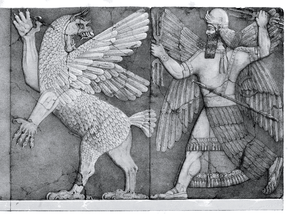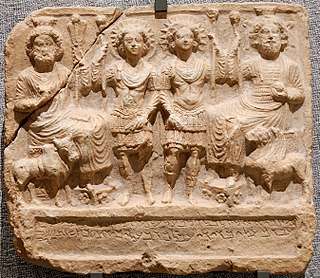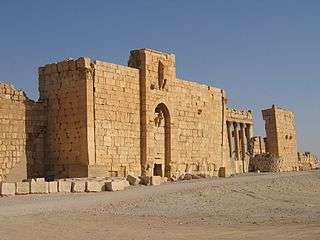Bel (mythology)
Bel (/ˈbeɪl/; from Akkadian bēlu), signifying "lord" or "master", is a title rather than a genuine name, applied to various gods in the Mesopotamian religion of Akkad, Assyria and Babylonia. The feminine form is Belit 'Lady, Mistress'. Bel is represented in Greek as Belos and in Latin as Belus. Linguistically Bel is an East Semitic form cognate with Northwest Semitic Baal with the same meaning.
| Part of a series on |
| Ancient Mesopotamian religion |
|---|
 Chaos Monster and Sun God |
|
Seven gods who decree
|
|
Other major deities |
|
Demigods and heroes
|
| Related topics |
| Part of the myth series on |
| Religions of the ancient Near East |
|---|
| Pre-Islamic Arabian deities |
| Arabian deities of foreign origin |
|
Early translators of Akkadian believed that the ideogram for the god called in Sumerian Enlil was to be read as Bel in Akkadian. Current scholarship holds this as incorrect, but one finds Bel used in referring to Enlil in older translations and discussions.[1]
Bel became especially used for the Babylonian god Marduk and when found in Assyrian and neo-Babylonian personal names or mentioned in inscriptions in a Mesopotamian context it can usually be taken as referring to Marduk and no other god. Similarly Bêlit mostly refers to Bel Marduk's spouse Sarpanit. However, Marduk's mother, the Sumerian goddess called Ninhursag, Damkina, Ninmah and other names in Sumerian, was often known as Belit-ili 'Lady of the Gods' in Akkadian.
Other gods called "Lord" could be and sometimes were identified totally or in part with Bel Marduk. The god Malak-bel of Palmyra is an example, though in the later period from which most of our information comes he seems to have become very much a sun god.
Similarly, Zeus Belus mentioned by Sanchuniathon as born to Cronus/El in Peraea is unlikely to be Marduk.
Bel of Palmyra, Syria
A god named Bel was the chief-god of Palmyra in pre-Hellenistic times, being worshipped alongside the gods Aglibol and Yarhibol.[2] Originally, he was known as Bol,[3] after the Northwestern Semitic word Ba'al[4] (usually used to refer to the god Hadad), until the cult of Bel-Marduk spread to Palmyra and by 213 BC, Bol was renamed to Bel.[3] The temple of Bel was dedicated to this god, which was destroyed by ISIS.[5]
 Bel of Palmyra, Syria, depicted on the far left alongside Ba'alshamin, Yarhibol and Aglibol on a relief from Palmyra
Bel of Palmyra, Syria, depicted on the far left alongside Ba'alshamin, Yarhibol and Aglibol on a relief from Palmyra
See also
References
- James Orr (1915). The International Standard Bible Encyclopaedia. Howard-Severance Company. pp. 349–. Retrieved 4 April 2013.
- Rostovtzeff, M. I. (1932). "The Caravan-Gods of Palmyra". The Journal of Roman Studies. Society for the Promotion of Roman Studies. 22: 107-116. doi:10.2307/297093. JSTOR 297093.
- Teixidor, Javier (1979). The Pantheon of Palmyra. Brill Archive. ISBN 9004059873.
- Drijvers, H. J. W. (1980). Cults and Beliefs at Edessa. Brill Archive. ISBN 9004060502.
- Romey, Kristin (26 August 2015). "How Ancient Palmyra, Now in ISIS's Grip, Grew Rich and Powerful". National Geographic News. National Geographic Society. National Geographic Partners, LLC. Retrieved 30 November 2019.
External links
| Wikimedia Commons has media related to Baal. |
- Bartleby: American Heritage Dictionary: Semitic Roots: bcl (Dead link. Archived 15 October 2008 at the Wayback Machine)